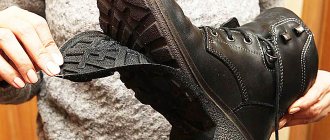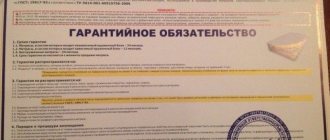What shoes can be returned to the seller without explaining the reason, what is regulated
The abundance of goods on the market often leads to low-quality consumer products. Shoes are classified by consumer protection legislation as a regular category of goods, which can also be returned to the store without explaining the reasons for refusal to use them.
Even regardless of the presence of obvious or hidden manufacturing defects, you can bring a box of shoes to the store and get back the money you spent on a pair of shoes.
If the case is not under warranty and the buyer does not require repairs, then even filing complaints or claims will not be required.
A product with an obvious defect, which the consumer could not recognize at the time of trying on, will be accepted voluntarily and without scandal. It is enough to inform the seller that the size was chosen incorrectly or that other wearing conditions do not allow you to walk in the shoes (calluses are rubbed, they get wet, a crack has appeared on the heel, etc.).
Let's look separately at which shoes can be returned within 14 days without explanation according to the law:
- Seasonal shoes. Often at sales with deep discounts, buyers seek to purchase discounted goods of good quality at a discounted price. But the purchased pair may not be used immediately, but will lie in the box for some time until the onset of the season (winter shoes can be purchased in the spring and lie in the box until December). It should be understood that seasonal shoes have “special immunity” to the return period, since their consumer properties can be checked only in the conditions for which they are intended. But stores are tricky with dates and offer such goods for purchase two weeks before the seasonality criterion is lifted. Thus making it impossible to return the pair to the store. If a manufacturer lists the materials on the top of a pair of shoes or boots, the sole is a mystery. The buyer will not immediately understand that the shoes are slippery and cannot be used during the period of the year for which they are intended. When the buyer likes the item, he wants to own it, regardless of the reason for contacting the seller again (the shoes are torn).
- Shoes for sports. Sneakers, sneakers and other sports shoes intended for active use may be returned, for example, due to the fact that the inside leaves marks on hosiery (dyes). This also indicates questionable quality and the inability to operate it in the intended conditions.
- Slippers. Slippers can also be the reason for returning to the store, but the seller will not be able to assess whether the pair has been worn (due to the characteristics of the place where it was worn). Often, slippers can be simply uncomfortable, since it is not customary to try them on in the store. A person simply selects the desired color and size, pays for the purchase and puts the slippers on his feet at home.
- Children's and teenage shoes. It is quite problematic to select such pairs, because small children cannot tell their parents that the shoes are bad and too tight. In Russia, the size range of a child’s foot is determined by eye or “by finger”, assessing the distance from the heel to the shoe. Subsequently, parents may see calluses or redness on their fingers, which makes further wearing of the pair unrealistic, which means that it is not the right size.
- Orthopedic (special) shoes. Often, especially for children, shoes are selected for medical reasons. Such products have specific features and are called orthopedic. Perhaps this is the only type of shoe product that can be non-returnable. If a pair is purchased in a specialized store or medical equipment, then there is a high probability that such shoes are classified as medical goods. When purchasing, you should first of all clarify how it is classified in the retail chain. Medical products (those that are selected based on the recommendations of the attending physician) are not subject to return or exchange in accordance with Government Decree.
Other types of “leg clothing” are subject to the general return rules. If shoes leak when they are made of resistant material that should not allow moisture to pass through, this is a good reason to return to the store.
It is extremely difficult to find a pair of domestically produced ones, but still for such shoes there is a very solid list of GOSTs and Technical Conditions. However, any goods imported into the country must be checked for compliance with safety of use; no one will compare the production process with that declared in Russia. In some stores you can find vapors with a strong unpleasant odor. It would not be out of place to say that such a product will not only “hit your pocket,” but will also cause harm to your health. And these are other grounds for returning the couple through the regulatory authorities of Rospotrebnadzor.
The consumer cannot evaluate production and compare its violation with the breakdown of a particular part.
Procedure for returning such products back to the store
It’s worth dwelling in more detail on how to behave in a situation where the shoes simply don’t fit for some reason:
- The first step is to pack the shoes back into the box with all the additional accessories that were included with the purchase (this could be heels, straps, shoe care products, etc.).
- Next, you will need to take with you an identification document and a receipt, although the store does not have the right to refuse without it, but having it will significantly save time.
- You should immediately prepare for the fact that the seller in the store may enter into controversy, trying to refuse to return the goods. This happens for a number of reasons, in this case you need to clearly stand on your position that the buyer has to make a return within 14 days, and the actions of refusal on the part of the seller are absolutely illegal.
- It is important to know that not only shoes purchased for cash, but also goods purchased on credit can be returned. In this case, of course, the procedure itself is more complicated, but not for the buyer, but for the seller, since he will need to carry out a number of manipulations to terminate the contract with the bank. The most important thing is that the shoes have not been worn, and that the tags or labels are in their original form.
- If a defect was noticed after some time while wearing the shoes, and there is a manufacturer’s warranty, then in this case the buyer also has the right to a return. There are cases when shoes were bought on sale, the warranty period begins to count from the start of the season. If there is a misunderstanding with the seller, then in this case you can contact the Consumer Rights Protection organization to clarify this information so as not to be unfounded.
- The return application must be drawn up in 2 copies, and it is important to note the date of purchase, any defects found, the cost of the product, as well as the request to the seller for a full refund. The first copy remains in the store, and the second copy remains with the buyer.
- Often, in controversial situations, the store conducts an examination, which should reveal how the defects on the product were formed. The buyer has the right to carry out such a procedure independently. If the buyer turns out to be right, the store will be obliged to compensate for the cost of the examination services.
- An extreme measure in resolving the issue may be an appeal to the courts, in the event that the dispute cannot be resolved in another way. If the court decides in his favor, then the seller will be obliged to reimburse not only the cost of the goods, but also return money to the plaintiff for the paid state duty, and also pay a penalty in the amount of one percent of the price of the goods.
Return procedure: algorithm of actions
To return a low-quality pair back to the store, you must meet some prerequisites:
- shoes must be packed in a box; the same as at the moment when a person bought the product;
- tags (if any) must be located in their places;
- take the sales receipt and warranty card;
- check whether the pair can be said to have been unworn outside before being returned; if there is dust on the pair, you should use a special product, since the seller must hand over clean shoes.
If steam of inadequate quality is to be replaced, it should be inspected to determine the possible cause of the defect. For example, a person was trying it on at home and discovered that the sole had come unglued in some places.
First of all, you should put the goods in the packaging and head to the store. Employees of most brands calmly respond to returns and ask you to fill out an application or choose another model. At the same time, if the consumer wishes to choose the appropriate product from another category, then he has no right to refuse him.
Here's an example: a pair of boots can be exchanged for shoes or sandals. The seller will either refund the difference in price or ask you to pay extra. If you like the model, but the size is chosen incorrectly, then if there is an appropriate size range, the consumer will be offered another pair to try on.
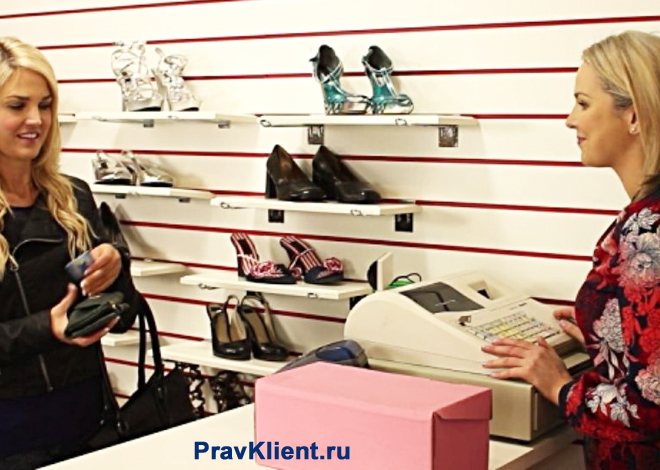
Some sellers are eager to identify the cause of the complaint. It is impossible to visually determine signs of wear, but on a certain part of the upper cover of the pair there are cracks or tears in the material. In such cases, it is possible to order an examination and wait for its results. Most likely, the return request will also be satisfied, since there is no other algorithm for action in the absence of traces of wear.
Does the law allow you to return purchased shoes if they are uncomfortable?
If we turn directly to the legislation, then in accordance with Article 18, paragraph 1 of the Law “On Protection of Consumer Rights”, the buyer, who discovers flaws in the purchased product, can:
- Replace with a product of the same brand, changing, for example, the size;
- Change the make and model, and recalculate to the new cost;
- Demand a refund for the poor quality of the product;
- Demand that the issue of damage to the goods be resolved on site by the seller or a third party, as well as reimbursement of your expenses, if any;
- Refuse the purchase and demand an immediate refund of the funds spent on the purchase. In this case, the goods are returned to the seller.
- If the purchase is in doubt, then the buyer has the right to replace a similar product, if suddenly the original option does not suit the buyer in shape, dimensions, configuration, color or size.
- Exchanges can be made within two weeks, excluding the day of purchase;
- A return can be made if the product has not been used for its intended purpose, its appearance has not been changed, and the buyer can present documents confirming the purchase in the form of a receipt. If there is no cash document, this does not exclude a return, since the testimony of witnesses present at the purchase may be taken into account.
- If replacement of the goods is not possible due to the lack of such goods on the day of the buyer’s request, then it is possible to refuse the purchase by demanding a full refund from the seller. Refunds by law must occur no more than three business days from the date of application.
Required Documentation
How to return unworn shoes to the store, at first glance, is extremely clear. But you should also dwell in more detail on the documents attached to the application:
- the receipt can be replaced by the testimony of friends who were nearby at the time of purchase; a lost check can be justified by evidence;
- the passport must be presented in original; such a requirement is imposed on everyone who demands the return of money; an identification document must be presented;
- the warranty card is usually attached along with the receipt, so it is easier for the buyer to find the required document; Moreover, the warranty card is signed by the seller, which will also simplify the identification of the product in the store.
Return shoes without box and receipt
According to paragraph 5, art. 18 of the Law “On Protection of Consumer Rights”, shoes can be returned to the store without a box or receipt. But for this you will have to take a number of procedural steps, and it is best to consult with a public organization that will be willing to do this. To receive money for a quality product that has no complaints, but it did not fit, you must:
- bring a real witness who was actually present when the act of purchase and sale was completed (no one has yet canceled liability for perjury, and the case may go to court);
- write an application for termination of the deed of sale and purchase in two copies, which contains a reference to the relevant paragraph of the Law;
- come to the store with a person who would be present when submitting the application, and even better, record the actions of the administration and staff;
- Leave one of the two copies in the store, ask for a resolution on the second copy about the seller (administrator, owner, person who carried out all the actions);
- send the shoes for an independent examination in order to detect a hidden defect;
- Cover your actions in the media and wait for the results of an independent examination.
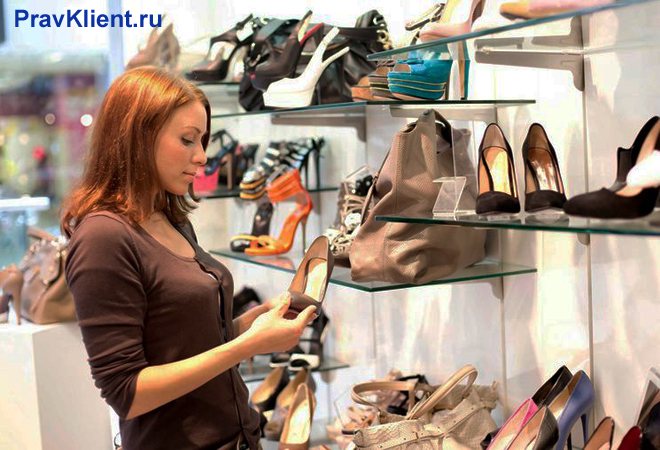
Perhaps she will find some hidden defect, on the basis of which not only the money for the product will be returned, but also the cost of the research performed. Since trade organizations are aware of the fine that is imposed if the claims are justified and were not resolved upon the first appeal by mutual agreement, it is likely that the money for the shoes will be returned without waiting for claims and acts.
The second option is if the packaging was missing at the time of sale, and the presentation was the same as at the time of return to the store. For this, you will also need a witness who will confirm that the new product was sold in the same improper condition as it was brought. Although the law does not have a corresponding requirement for the safety of packaging, and this is only a matter of conscience and accuracy.
Documents that may be required and possible claims:
| Return without box and receipt Conditions for returning quality shoes | Return of low-quality shoes | Claims to meet requirements |
| Identification | Application with claims and information about the seller | Defective goods |
| Statement | Identification documents of the buyer (to confirm the data in the claim) | Inconsistency with the information provided (the leather is not actually leather) |
| Written testimony of a witness (it is better to do this in advance) | Warranty card or items of product packaging Warranty provided | Boots are sold as winter boots, but do not correspond to the winter assortment |
| Possible arguments (guarantee card or bank statement) | The second copy of the application, which remains with the buyer | Any biased information that misleads the buyer (for example, quality) |
Return deadlines
In accordance with the norm of Article 25, without giving reasons, you can return the goods within the next fourteen calendar days, not taking into account the day on which the purchase was made.
A controversial situation may arise during long calendar holidays, but the retail network operates in such a way that the consumer has the opportunity to make purchases or exchange goods every day (regardless of holidays). An exception to this rule is New Year's holidays.
In other cases, you can rely on Article 19 of the Law on the Protection of Consumer Rights, which allows you to make demands on the seller in accordance with signs of questionable quality of the products sold.
If a guarantee is not established, then the consumer should keep in mind that the period of treatment is not specified in the law, but has the wording of “reasonableness”. Usually it is a couple of months. There is also an unconditional and non-refundable period of 2 years. It’s hard to imagine that a pair will lie in a box for so many years, but you can still use this standard. It does not focus on a specific type of product.
There is another very important nuance regarding the timing of returning a pair of shoes. Online stores sell this product. A person selects shoes from a picture from an online catalog and waits for their delivery. The period begins to run from the moment he signs for receipt. Many similar stores on the global web allow you to try on before purchasing, that is, the courier service will wait until the person puts the pair on his feet and is sure that it fits.

Again, trying on at home allows you to identify defects and contact the store. There is a need to apply in the same way as the purchase was made, and the time frame for reviewing the claim will be the same as when visiting a real sales floor.
Are orthopedic shoes returnable?
The issue of returning orthopedic shoes is often controversial. Some argue that this is a medical item, others that it is a regular wardrobe item that is subject to standard returns. The answer is simple - orthopedic shoes can be returned to the store or exchanged for similar ones on a general basis, in accordance with the Law of the Russian Federation of 02/07/1992 N 2300-1 “On the Protection of Consumer Rights” (as amended on 11/25/2006), Resolution Government of the Russian Federation dated January 19, 1998 N 55 “On approval of the rules for the sale of certain types of goods...” (as amended on December 15, 2006). Accordingly, it can be returned either within 14 days from the date of purchase, or within the time limits established in the contract.
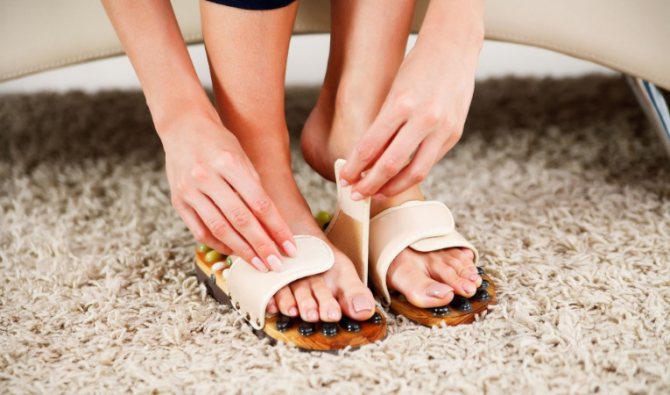
What to do if the seller refuses to accept the goods
Refusal to accept shoes may be accompanied by a visual determination of the degree of wear. The seller will justify the refusal either by the expiration of the warranty period or by the impossibility of accepting the pair due to significant signs of wear. We can say that the pair was used incorrectly, was not treated with special means, or was simply worn carelessly.
In this case, you should receive a written refusal and go with it to the local office of Rospotrebnadzor. The examination will be appointed by the supervisory authority. With this conclusion, you can contact the seller again. If this does not help, then such a dispute is subject to consideration in court. The costs incurred by the consumer in connection with the proceedings must be returned to him if the claim is satisfied. But if it is impossible to comply with the claim procedure for the dispute, then contacting Rospotrebnadzor and the store will solve this problem. In this case, you can also ask for compensation for moral damage. But this is a separate claim that can be combined with the main one.
RIGHT OF RETURN

In winter, the most popular products submitted for examination are fur coats and shoes. Consumers bring items that they are almost 100 percent sure are defective. Meanwhile, according to experts, a significant number of buyers are mistaken. In their opinion, a false assessment of the causes of defects in goods lies in the difference between two concepts - “manufacturing defect” and “defect due to the fault of the manufacturer.” The quality of goods is regulated by the country's legislative acts, standards, regulatory and technical documentation of the enterprise where this or that product is produced. Any non-compliance with this standard - GOST - is considered a defect or manufacturing defect.
For example, the standard for fur products is regulated by the following points:
— longitudinal and transverse seams should not be skewed;
— skins are selected according to shade, shine, and hair height;
— inserts in the product must strictly correspond to the quality and color of the main skins;
— the lining should be in harmony in color and quality with the fur top;
- fur products made from dyed skins should not stain clothes;
- the leather fabric of fur skins must be soft, elastic, “non-rattling”, without grease stains;
— the coating should not crack or crumble when subjected to repeated bending;
- seams must be made with strong threads matching the color of the leather fabric without catching hair, gaps or cuts.
Shoes have their own evaluation parameters:
— absence of through damage to parts, cracking, peeling and stickiness of the coating film of the upper and lining material;
— shoe parts must be correctly positioned, the seams are well connected;
— the sole is well-glued;
- the heel must be placed correctly;
— the leather must have a stable coating and be free from cuts, sprains, and abrasions;
— the lining is well glued and sewn.
What is considered marriage and what is not?
Change in fur color is not a defect. Fur changes color over time; this is a natural process for which the seller is not responsible. Sometimes a new fur coat starts to have fur coming out along the seam (the so-called “trimming” - hairs damaged when cutting the skins). If this is due to pruning, then over time they will stop coming out, and this case does not apply to marriage. If there are no fewer of them and the fur is constantly coming out of the fur coat, then the reason is poor-quality dressing of the skins - this is a defect. Low-quality fur becomes noticeable already during the first season of wearing a fur coat. If the fur begins to come out in the second year, most likely the fur coat is not stored correctly. If a fur coat stains clothes and hands, this is a defect, it must be returned or exchanged for another that does not stain. The paint will not fix over time, and the fur coat will be painted constantly.
When under the lining there were holes in the leather fabric and protruding fur in the seams - these were traces of nails or staples, with the help of which the skin was straightened. In these cases, this is part of the technology of sewing a fur coat, and not signs of defects. The same can be said about the hairs that stick out from the seams. When two skins are sewn together along the edge, some of the hairs end up inside the fur coat; this is also not a defect. The fur has rolled up, the lining has come off, the fur has torn at the seam or nearby, and the fur coat is only one or two years old - this is definitely a defect, and there is a reason to return the fur coat under warranty. For example, a high-quality mink coat should be worn for at least 5-8 seasons. For shoes, the following are considered defective: a defect in the shoe upper, insole and sole, as well as shedding of dye, destruction of seams, splitting, fracture and tearing of the heel, subsidence of the heel.
Izhevsk experts examine fur coats and boots for defects in accordance with the specified parameters. The functions of the Committee for the Protection of Consumer Rights, which was abolished two years ago in Izhevsk, have today migrated to Rospotrebnadzor UR. Now it is within the competence of this department to provide consultations to citizens on issues of consumer protection. But consultation is not the only thing a buyer of a low-quality product can count on. In addition to guidance for action, Rospotrebnadzor specialists must help file claims when it is necessary to defend the return of money for a defective product in court. But not more. All related procedures are paid, as a rule, at the expense of the consumer or seller, if the warranty period of the product has not come to an end. Product examination can be carried out in several specialized organizations in Izhevsk. On average, experts charge from 400 to 1000 rubles for the service. The evaluation of a product, be it shoes or a fur coat, is carried out exclusively “by eye”. As they explained to me at the Chamber of Commerce and Industry, in the republic almost none of the institutions of this type have either the equipment or reagents to conduct a complete and objective analysis of products. The examination itself lasts about 40 minutes. Experts work with consumers by appointment. An order form is drawn up on site, on the basis of which the expert examines the existing defects. Upon completion of the inspection, a conclusion must be issued that can be used when returning the goods. Experts also help prepare all the necessary documents for the court if the legal return of funds has not been made.
When, in the process of preparing this material, I talked with experts from the Chamber of Commerce and Industry, they explained to me that the fur from which my fur coat was made did not correspond to what was declared. Instead of the supposed beaver, my fur coat turned out to be from a much cheaper rabbit. But this is only an oral statement, which can be confirmed after laboratory testing. It can be held in Izhevsk in several private organizations, but for decent money. On average, a laboratory test of a fur coat costs 3,500 rubles (+ interest is added to the cost of the product). If the product costs more than 20 thousand rubles, experts will ask for an additional 20 percent of the total cost. It is doubtful that under such conditions there will be many people willing to use this service, because you can spend more than 4,000 rubles and receive a written conclusion that the previous expert made a false statement and the fur coat is, after all, made of beaver.
How and within what time frames are returns and replacements made?
If the purchased product does not suit you for any reason, in accordance with Art. 25 of the Law of the Russian Federation “On the Protection of Consumer Rights” provides for the consumer’s right to exchange goods within 14 days. In this case, the goods must not be in use; their presentation, factory labels, as well as sales and cash receipts must be preserved. If you were unable to receive the desired product for exchange, the seller is obliged to return the money spent on its purchase to you.
In the event that a manufacturing defect is discovered during wear, the consumer is protected by Art. 18 of the Law of the Russian Federation “On the Protection of Consumer Rights”. According to this provision of the law, the buyer must file a claim against the store in 2 copies and present one of five demands:
— free elimination of product defects;
— proportionate reduction in the purchase price;
— replacement with a product of a similar model or article;
— replacement with the same product of a different brand or model with recalculation of the purchase price;
— termination of the purchase and sale agreement.
If the consumer discovers defects in the product and submits a request for its replacement, the seller is obliged to replace such product within seven days. If the seller does not have the goods necessary for replacement at the time of submitting the demand, the replacement must be carried out within a month or a refund must be made.
According to Art. 18 of the Law “On the Protection of Consumer Rights”, the buyer of a product that has become unusable has the right to return the purchase of inadequate quality even after the expiration of the warranty period. If significant defects in a product are identified, the consumer has the right to make a demand to the manufacturer to eliminate such defects free of charge if he proves that they arose before the transfer of the product to the consumer or for reasons that arose before that moment. Such a claim can be made within two years from the date of purchase of the goods. If this requirement is not satisfied within twenty days, the consumer has the right to demand a refund of the amount paid. Your absence of a cash receipt or sales receipt or other document certifying the fact and conditions of purchase of the goods is not grounds for refusal to satisfy your claims during the warranty period. But if the warranty period has expired, then if the receipt is lost, the consumer must provide other evidence that the product was purchased in this particular place. If a sheepskin coat or fur coat is damaged (or lost) in a dry cleaner, the consumer is required to pay compensation - twice the cost of the product. If they cleaned it poorly, they must redo it.
Samples and forms of documents
A sample complaint to a shoe store can be found on various websites. In stores, you can get a form from the administrator, and then you will not need to clarify the exact name of the store or find out the name of the manager.
All you have to do is fill in your details and information about the product. Do not forget to indicate in the application what the buyer ultimately wants to receive. If it is cash, the employee will track down the payment and return the money. When payment was made from a bank card, it must be present at the time of return. The seller carries out transactions using the same details and in the same way as in the first case.
Features of returning goods that do not correspond to the buyer’s personal preferences
Often people, not knowing their rights, or simply because of natural modesty, do not contact the seller with a request for an exchange, continuing to wear shoes that do not meet the requirements that the buyer expected. This position is incorrect, since the buyer has every right to familiarize himself with the product and, within two weeks, make an exchange or return the money spent on the purchase.
If communication in a store is carried out with an incompetent employee who categorically refuses to accept the client’s request, then the complaint should be sent to the manager. If the case is completely advanced and the demands remain unanswered, then you can send your complaint against the store to an organization that deals with consumer rights protection, attaching all the necessary documents confirming the purchase of the goods, as well as a copy of the appeal that was drawn up in the store.
Can shoes be returned or exchanged?
Read about how to return shoes without a receipt here.
How to return shoes without a box, read the link:
Features of the procedure
First of all, you need to find the administrator of the point of sale or the general manager and write a complaint so that he can correct the situation. Otherwise, you may encounter an incompetent cashier who unreasonably does not allow you to return a pair that does not fit or is torn.
All original documents must be in the hands of the buyer, otherwise there is a high probability of losing the receipt and, as a result, difficulties in returning the money. It will be impossible to restore the check.
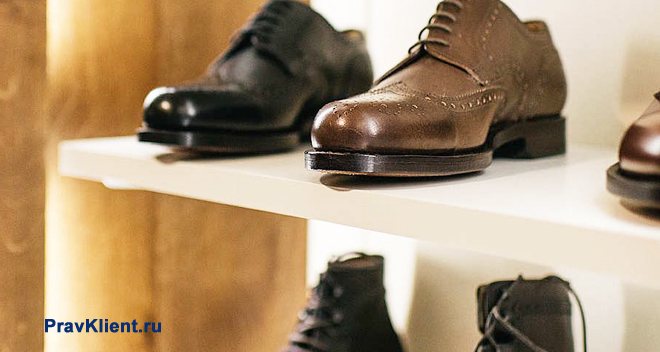
The last feature of the procedure is that deceiving the seller may be fraught with criminal prosecution for fraud.
Shoe return policy
Shoes are not goods that cannot be exchanged or returned. The list of Government Resolution No. 55 of 1998 does not contain it. In order to freely return a product, you need to follow several rules:
- preserve the consumer appearance of the product, it must be unworn;
- save the receipt;
- have time to submit it within the deadline established by law - two weeks.
Preserving the appearance means not subjecting the product to wear; there should be no traces of dirt on it; if possible, it is worth preserving the labels and tags on it. If the receipt is not saved, then witness statements may come into play. By following all these rules, the seller will not be able to refuse the consumer to protect his rights.
Return of shoes under warranty during the warranty period
Before you buy your favorite pair of sandals, you need to ask whether they have a warranty. The answer to this question determines the buyer's potential ability to return the product if a defect is discovered.
The warranty card is issued for an average of two to three months. The warranty period begins from the date of purchase, and if a seasonal product was purchased much earlier, then from the beginning of the season. For example, the warranty for winter boots purchased in the summer will begin on December 1.
The warranty period applies only to the delivery of defective and defective shoes.
Returning shoes to the store after a short wear
You can return an item after a little wear only if a certain flaw was discovered during the warranty. A little wear implies the possibility of eliminating the defect, for example, the ability to repair the fastener, adjust the heel cap, etc.
After wear, an examination is often prescribed to determine the causes of the defect. The defect may be a factory defect, or it may arise as a result of improper use on the part of the buyer. For example, rag ballet shoes were worn in slush and rain, as a result of which they came unstuck. If the examination shows that the consumer is at fault, then the money for the inspection will be reimbursed.
Returning shoes purchased at a discount
Often, in order to increase demand and sell shoes faster, the seller may discount them. Products purchased at a discount are returned according to general procedures in accordance with the law. There are no special requirements for discounted items.
Warranty periods
The exact warranty period is not specified in the ZPPP.
However, Article 19 states that the client can write a complaint about the return no later than 14 days from the date of the transaction. In addition, the warranty period depends on the type of shoes purchased:
- All-season shoes can be worn all year round, regardless of weather conditions. This type of footwear includes shoes, house shoes and sports shoes.
- Seasonal shoes are worn for 1-2 seasons. In autumn and spring, women often buy light boots or eye-catching high-heeled boots, while in winter preference is given to more practical shoes with flat soles.
The beginning of the warranty period for all-season shoes is the date of purchase, and for seasonal shoes - the onset of the corresponding season.
The climatic conditions in which the product will be used are also taken into account.
The period during which the buyer can, in the event of discovery of hidden defects, file a claim with the seller is established by law. No retail outlet has the right to change it.
Legal grounds for returning goods without presenting a receipt
As previously reported, the Law “On Protection of Consumer Rights” regulates the relationship between the seller and the buyer. It is the main document that protects the buyer and also facilitates the resolution of disputes that arise. The law allows the buyer to return purchased goods of proper or inadequate quality back to the store. However, a prerequisite is compliance with the deadlines provided for by the Civil Code of the Russian Federation.
If a shoe store refuses to comply with the buyer’s request to return or replace the product, the buyer has the right to write a statement addressed to the director of this store with a claim (complaint), referring to the relevant articles of the Law. Such a document is drawn up in two copies. Remember that it is imperative to require acceptance of the application from the owner of the salon with his signature and appropriate seal.
The law that protects deceived buyers makes it possible to resolve a conflict that has arisen with the seller in two ways: either by appealing to Rospotrebnadzor or by going to court. The Federal Service will provide recommendations for a step-by-step solution to the problem, and will also tell you what to do if you lose a check.
It often happens that after informing the store owner or seller about his intention to contact the consumer protection authorities (Rospotrebnadzor or the local Consumer Rights Protection Authority), the buyer receives the necessary requirements. To a greater extent, this scenario is typical for large chain stores that value their authority. Please be aware that measures of liability for owners for violating the rights of buyers have been strengthened in 2015.
The new version of the Law (from 2020) states that the seller is obliged, if the client’s legal requirements are not satisfied, to fully compensate for the cost of the product itself, the moral damage caused and the penalty (fine). If the seller does not fulfill the claim within 10 days after the buyer’s request to fulfill his requirements (replacement of goods or refund), then the buyer can safely demand payment of compensation (penalty) for each day of delay.
How to return money for goods to a legal entity?
Read about how to return children's clothing to the store here.
How to write an application for the return of low-quality goods, read the link:
Writing a claim
If the problem is not resolved peacefully, you need to change tactics and start by filing an official complaint. You can write it by hand or type it in print.
When drawing up a document in free form, the client must provide the following information:
- passport details;
- exact address of the outlet;
- information about the product that will be returned;
- reason for return;
- requirements for the store (exchange or return);
- links to articles of law confirming infringement of consumer rights;
- date and personal signature.
If each party blames the other for the formation of a defect, an independent examination of the quality of the shoes can be carried out.
Sample claim
In the upper right corner you must indicate the full name of the store and legal address.
Please fill out the applicant's details below (full name, postal address and contact phone number). In the center of the document its name is written, in this case “Claim”, and below is the main text.
A typical claim template would look something like this:
- “December 12, 2020 in the Monroe store, which is located at: Moscow, st. 9-ya Parkovaya, 61A, I purchased a pair of black leather winter boots worth 10,000 rubles (if you have documents for the shoes, it is advisable to indicate the exact name and article number of the model).
- There are documents for the purchased product that indicate that the warranty period is 1 month from the date of purchase.
- During the warranty period, it was discovered that the shoes did not correspond to the declared quality, since the back of the boots tore along the seams, and deep cracks formed in the front. Ultimately, the purchased product became completely unusable.
- In accordance with Article 18 of the Law of the Russian Federation “On the Protection of Consumer Rights,” I demand that the goods be accepted back and the money for the purchase be returned within the time frame provided for in Article 22 of the law.”
After the main text, you need to list all the documents that will be attached to the application, put a date and signature.





